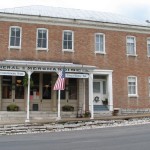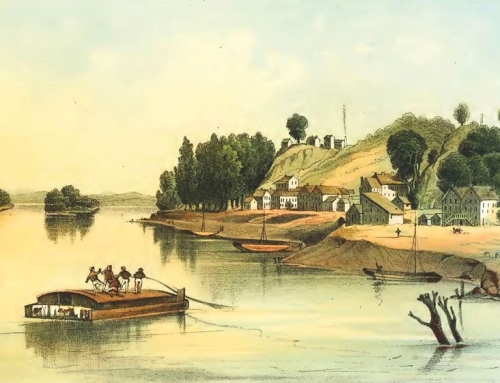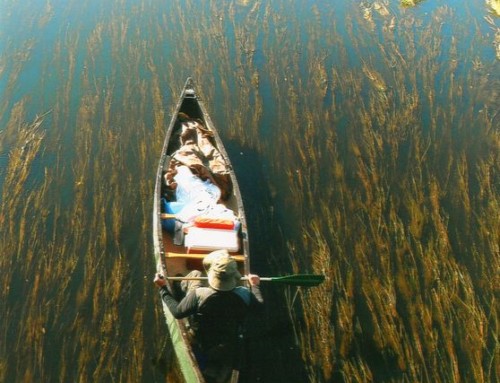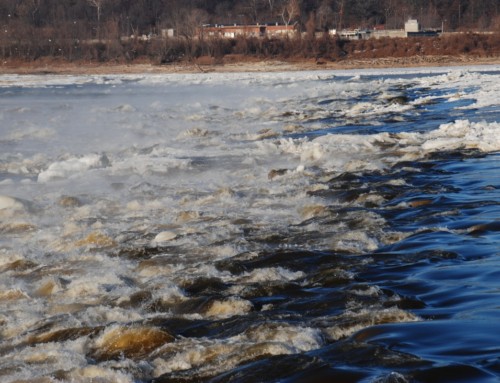I feel restless. I have spent too much time working at the home office and need to get out, get away, right away. I need a trip. I love visiting new places, new countries. I want to explore new territory, even though leaving the US in the next hour or two seems unlikely. Where can I go in a day? Hmm, there is much I have yet to explore in my own backyard. I think I will brew some coffee and look over the Atlas. What about exploring the Great River Road south of St. Louis? Aha, that will work. I grab a stack of CDs and my Illinois map, leave the house, and point my Prius south.
After crossing the Jefferson Barracks Bridge, I take Illinois Route 3, part of the Illinois Great River Road, to Waterloo where I veer off the main road to Maeystown. Located next to a small creek among gently rolling hills, Maeystown has several well-kept 19th century brick and stone buildings – impressive for a town of 150 or so residents. In “downtown”, you can visit the history museum, shop for antiques, and have an ice cream. I feel the need to keep moving right now, but I want to come back here for one of the town’s many festivals.
From Maeystown, I descend toward the Mississippi River and drive south on Bluff Road, the real Great River Road. I love being near the Mississippi (even if I hate typing the word over and over). The river cuts a deep path through the surrounding landscape, with tall bluffs on either side of the flood plain. This time of the year most of the crops have been harvested but the landscapes are populated with wildflowers in bloom and fields of sorghum with its brown tops stretching across the landscape. With Mississippi Fred McDowell singing the Delta Blues to me, I speed along with the windows cranked down. My bliss is rudely interrupted when a burst of cold air comes rushing out of one of the many caves along the bluffs and right through my car.
Just down the road apiece is Fort de Chartres. The original stone fort was built by the French in the 18th century and had a short life, roughly from 1760 to 1771. Some structures have been rebuilt to historic specs, which makes for a really cool place to watch people in period costumes making camp for Rendezvous. On a slow day, like when I was there, I imagine that the quiet solitude of today is much as it must have been in 1760. I chatted for a while with Debbie, the owner of the gift shop, who was decked out in period drag.
After a quick drive around the nearby village of Prairie du Rocher (there is no other kind), I am back on Bluff Road trying to find the Pierre Menard House and Fort Kaskaskia. Menard was the first Lieutenant Governor of Illinois, which seems a lot like being the first class secretary of Millville Middle School – does it really matterto anyone but your mother? He built an impressive French Colonial house, though. From his spread, I hike up a hill to see Fort Kaskaskia. Let me help you visualize the fort. First, picture yourself standing in your front yard, or your neighbor’s yard if yours sucks. Now, imagine that this yard has a couple of hills covered with grass. There, you just saw Fort Kaskaskia. Now you don’t have to go there yourself. In fairness, if you walk past the grassy humps, there is a spectacular view of the Mississippi River and an island that was the site of the original village of Kaskaskia in 1703.
Chester is a short drive from the, um, fort and is another old river town with a few sights to see, including the old correctional center, a psychiatric hospital, and a bronze statue of Popeye. Elzie Crisler Segar, the creator of Popeye, was a Chester-ite, hence the statue. Nowadays, you can celebrate the fictional character’s life at the annual Popeye Picnic, usually held the first weekend after Labor Day. I miss it by one week. Chester also has a covered bridge just east of town, thoughtfully preserved in a roadside park.
I am anxious to get out of the car for a while, so I swing over to Pyramid State Park. Actually, I swing around Pyramid State Park. I can’t figure out where the entrance is and there are no signs on Highway 150, so I end up driving nearly the whole damn perimeter of the park before I find my way in. By then, it is just after 5pm, so I only have about an hour to hike. For Labor Day weekend, the park is very quiet.
Dusk is quickly settling in, so I drive back to Chester and cross the very narrow bridge across the Mississippi River. I would hate to cross that thing with an 18 wheeler coming at me.
The sun is setting over Missouri fields only recently relieved of corn. I drive the back roads to the town of St. Mary, which is the only way to reach the island town of Kaskaskia, the heir and namesake of the one of the oldest villages in the Midwest. Kaskaskia is the only town in Illinois that is west of the Mississippi River. It used to be east of the river, just like it used to be the state capital of Illinois, the first one at that. Times change, a fact not unknown to the residents of Kaskaskia, who barely have a town now. According to the 2000 census, it has nine residents. Nine! Even so, Kaskaskia has a beautiful old brick church, The Church of the Immaculate Conception. Kaskaskia is also home to something called the “Liberty Bell of the West” at Kaskaskia Bell State Historic Site. Those sights will have to wait for the next trip.
The loss of the state capital did not kill Kaskaskia, but a series of floods over the past century and a half, including the Great Flood of 1993, have more or less finished the job. Remember those pictures of livestock being rescued from the tops of barns in 1993? That was Kaskaskia.
That is about all I have time to do, as the last remnants of daylight are nearly gone. I stop in Sainte Genevieve for a quick and mostly unsatisfying meal at my first and last Huddle House Restaurant, then take the fast road home. Our region is rich with historic river towns, each with its own story to tell. I am looking forward to getting to know more of these communities in the future.
© Dean Klinkenberg, 2006







